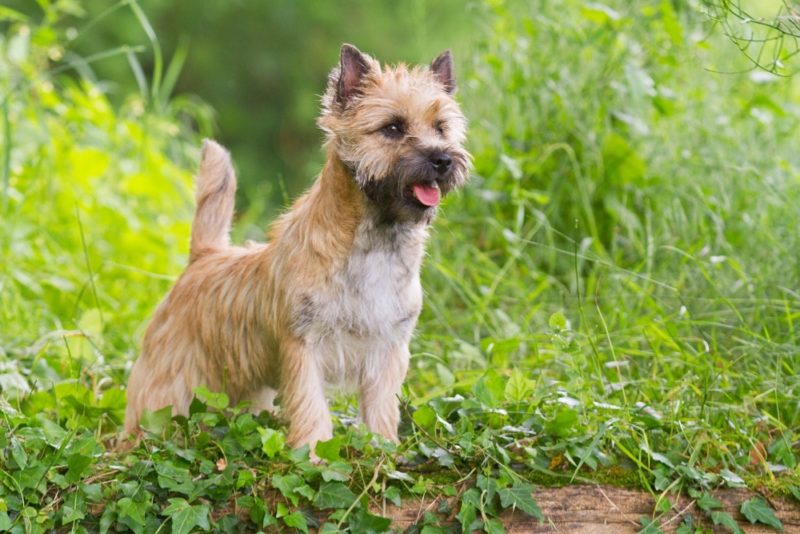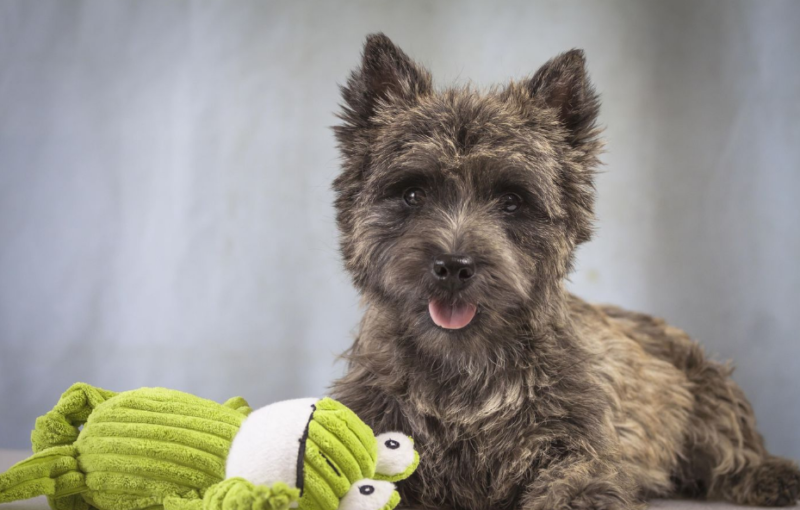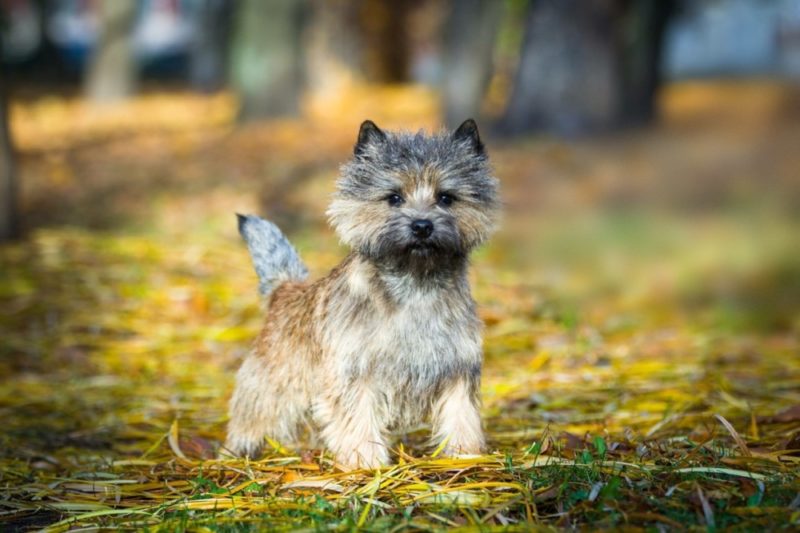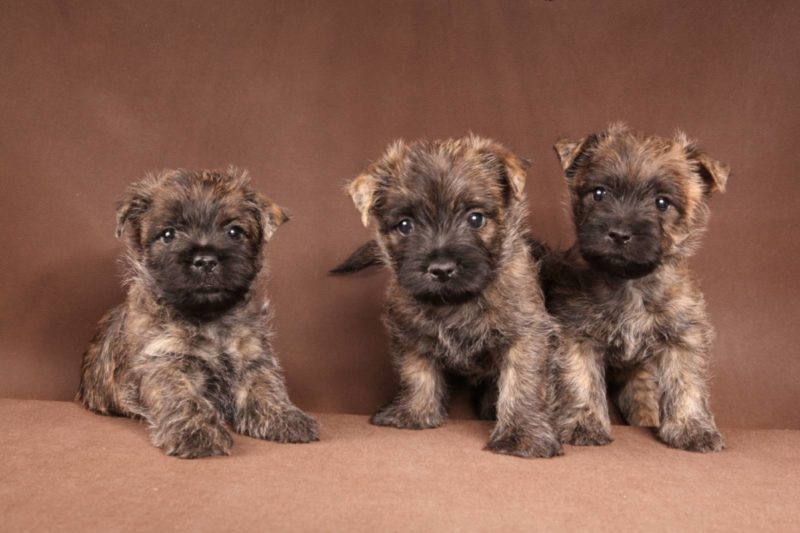The Scottish dog Cairn Terrier is an almost universal pet due to its many positive qualities. How was this breed created, and what is characteristic of these animals?
Material Content:
Breed description
Cairn terrier (cairn terrier) - a miniature dog, for a long time remained unpopular among potential owners. Indeed, the peculiar appearance of the animal, as well as its impressive hunting skills, made these terriers popular exclusively in select circles. Over time, however, many people appreciated the small size, positive nature and unpretentiousness of these dogs.
The decisive role in choosing such a pet is, of course, small in size. Cairn terrier weighs about 6.7 kg with a height of 20 - 27 cm.
Note. Cairn terrier is very similar to another miniature and active doggie - Norwich Terrier. Two dogs are easily confused until they are placed next to each other. In this case, it can be seen that the cores are somewhat larger than the Norwich, and the latter are distinguished by a richer color and greater rigidity of the wool.
Origin history
For the first time, core samples appeared on the territory of Scotland, on the Isle of Skye. Due to this fact, they were called sky terriers until the 20th century. The first mention of these animals dates back to the 16th century. Even then, this hunting dog breed was actively used in the harassment of hares and foxes. Then these terriers were nicknamed the Scottish earthen dogs.Unfortunately, there is no detailed description of these animals; therefore, it is very difficult to determine which dogs became the ancestors of modern cores.
In the middle of the 16th century, King James 1 presented several Scottish dogs to his “colleague” - the king of France. He was extremely pleased with the gift, and the little terriers gradually began to gain more and more popularity among the inhabitants of the Old World.
Did you know? The word core (cairn) refers to the Gaelic language, which, in turn, is a kind of Scottish dialect of modern English. Translated, this concept means "pile of stones." This name perfectly reflects the purpose and nature of these dogs. After all, they were recognized to drive mining from stone shelters. Since most terriers work in earthen burrows, cores in this case are considered almost unique animals.
A few centuries ago, people who kept a bunch of terrier hunters were considered prosperous, because these animals were a kind of indicator of a person's belonging to a high social class. It should be noted that the destruction of rodents in England and Scotland over time has become almost a paramount task. This is understandable, because badgers, rats and other pests spoiled the wheat crop. Terriers intended for such an important mission were selected very carefully, taking into account all indicators: courage, dexterity, speed and so on. Such a tough selection made it possible to create practically universal dogs that perfectly cope with work in stone burrows. It is noteworthy that much more stringent requirements apply to the core terrier than to other terriers. And all because working in stones implies a much greater risk than bullying a beast in a hole.
The breed of cairn terrier was recognized thanks to the English breeder by the name of Campbell. It is to this day that she is considered the patroness of these doggies.
Thanks to the efforts of the breeder, the cores were separated into a separate breed and since the beginning of the 20th century, core and sky terriers are considered different animals. By 1915, “stone” dogs were recognized in the world. Gradually, the breed standard was developed, and the cores finally took their rightful place in the dog world.
The nature and behavior of the core terrier
Cairn terriers - dogs, which include many advantages. These are bold, loyal and active creatures. Their temper is not distinguished by obedience and meekness, but these dogs are born hunters, and, therefore, must be able to make decisions and take initiative.
At the same time, these dogs are quite friendly to members of their family (especially to children), as well as other pets (even cats). However, the owner should not discount the hunting instincts of the core and plant rodents (guinea pig, rabbit or hamster) in the house, since energetic dogs can take such animals for their prey.
Standard and choice of puppy
Having decided to acquire a core terrier puppy, the potential owner should rely on the breed standard of these four-legged:
- The head is regular triangular in shape and small in size.
- The transition from the forehead to the muzzle is quite pronounced.
- The muzzle is slightly reminiscent of a fox.
- Teeth strong, but not very large, correct bite
- The nose is of a dark shade, the organ of smell is open and mobile.
- Eyes are rounded, the color is dark and saturated.
- High set ears have the shape of a triangle.
- The body is strong, slightly elongated.
- Short and wide neck smoothly goes to the withers.
- The chest is narrow and lowered, the back is wide, smoothly turning into a strong lower back.
- The limbs are proportional, the forelegs are slightly larger than the hind legs, due to the skills of digging the earth.
- Medium-long tail set high.
As a rule, “earthen” terriers are not stopped, and in their historical homeland, Scotland, the shortening of core tails is strictly prohibited.
The core coat is smooth, however, a slightly wavy coat is also not considered a deviation from the standard. Hair is hard, medium length. Suppose gray, brindle, red, black and sand colors.
Choosing core babies, which should later become hunters, you should certainly be interested in the working qualities of at least one of the parents. As a rule, hunting skills are passed on to dogs by inheritance. The breeder must provide the buyer with the entire package of documents for the puppy, including the pedigree and veterinary passport with vaccination marks. Core puppies are active, curious, playful.
Features of the content of the animal
The compact dimensions allow the owners to contain cores in the apartment, however, in a private house they will be comfortable. Cores with pleasure will frolic in personal plots, going for a walk even at low temperatures. But releasing a pet into the yard, one should not forget about his addiction to digging. A core left overnight in the courtyard is capable of prematurely “harvesting” the crop planted by the owner, or even digging under the fence.
Care, health and feeding
Caring for a core terrier involves taking care of the pet's coat. Once every six months, grooming should be carried out. To entrust a haircut is best to a professional in a special salon.
Grooming procedures should not be ignored, only in this case the appearance of the dog will be neat and aesthetic. Also, cores need to be combed out 2-3 times a week, during molting - more often. If during the period when the dog loses hair, combing will not be performed, the pet may suffer from skin diseases.
Nature endowed these dogs with powerful claws, and therefore they can be scratched worse than any cat. Terrier claws are cut once every 3 weeks.
Features of feeding dogs of the breed Cairn Terrier depend on the presence of food allergies in the latter:
- If it is absent, natural products can be included in the diet of dogs: low-fat meat (turkey, chicken, rabbit), vegetables, cereals (rice, buckwheat), fruits, dairy products.
- For allergic dogs, it is best to purchase specialized dry food or follow a natural diet, the features of which are best discussed with your veterinarian.
The average life span of a core terrier is 15 years. But subject to proper care, dogs can live up to 18 years, maintaining their energy and activity. Good health is considered an additional plus of cores - these animals are very little susceptible to various diseases.
But there are exceptions to any rule, and the following problems may await small terriers:
- Obesity. This diagnosis can be attributed to a full-fledged disease of tetrapods. Unfortunately, many owners, especially those living in the apartment, mistakenly attribute the core terrier to decorative dogs, depriving them of full physical activity. If the latter fact is combined with overfeeding the animal, obesity and the subsequent negative consequences for the health of the dog (problems with the liver, joints, hormonal system) are provided.
- Von Willebrand disease. Hemophilia-like disease. It usually affects dogs under the age of 1 year. The main symptoms of the pathology are sudden bleeding, which is difficult to stop. Pathology is considered hereditary, but modern breeders, having discovered its signs, exclude sick dogs from breeding.
- Legg-Perthes disease. A disease similar to joint dysplasia, but having a genetic basis. Dogs with this disease are not allowed for breeding.
- Cataract. Often, problems with the eyes of core samples are caused by a lack of grooming and proper care for the organs of vision.
- Dislocation of the patella. May be congenital and acquired. Almost all varieties of terriers are prone to this problem. The forecast largely depends on the promptness of the breeder or owner.
- Allergy. Most often, allergens are pollen and food.This problem is solvable, but requires an individual approach.
The potential owner should take into account that most core diseases are hereditary, and therefore it is better to take dogs from trusted nurseries.
Puppies from breeders who value their reputation have confirmation of the absence of genetic pathologies.
Raising and training a hunting dog
Many owners compare the process of core training with a roller coaster, and all because of the choleric and sometimes explosive nature of the pet. Small “earthen” terriers are assertive and cunning, and therefore, before buying an animal, you must come to terms with the fact that training will not be quick. These dogs will not meekly wait for the owner’s commands and, having noticed a hare or a hamster, most likely will follow him, regardless of the owner’s wishes.
If you take into account and be patient with such features of temperament, no special problems with the core are expected. The owner should not let the pet off the leash without any special need.
If the representative of the breed of core-terrier is not intended for hunting, you can choose a number of alternatives to this occupation. For example, agility classes, where a doggie will be happy to catch frisbee and engage in other types of physical activity. In addition, the owner can occupy the pet on his own by teaching him the “Seek” team. After that, you should hide the toy in a pile of stones, looking for it, the pet will feel like a real hunter.
Pros and Cons of a Cairn Terrier
The advantages of the Cairn Terrier dog breed include:
- cheerful and lively disposition;
- readiness for games and activity;
- lack of difficulty in leaving;
- love for children;
- the possibility of living in a small dwelling;
- convivial character.
However, there are a number of disadvantages that should be taken into account:
- The activity and indefatigable energy of the cores will not suit the owners-melancholic.
- Excessive courage. Brave cores are not always able to compare the size of a potential adversary with their own. So, these dogs can get into a fight even with a rottweiler.
Active core terriers are real clots of energy. Agile, agile, they more than compensate for their small dimensions. The owner should provide the pet with motor activity and frequent walks.

















